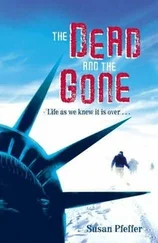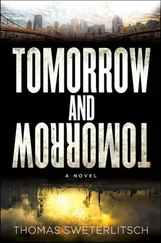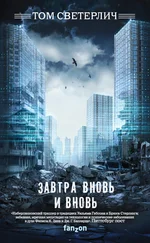Том Светерлич - The Gone World
Здесь есть возможность читать онлайн «Том Светерлич - The Gone World» весь текст электронной книги совершенно бесплатно (целиком полную версию без сокращений). В некоторых случаях можно слушать аудио, скачать через торрент в формате fb2 и присутствует краткое содержание. Город: New York, Год выпуска: 2018, ISBN: 2018, Издательство: G. P. Putnam's Sons, Жанр: Детективная фантастика, Триллер, на английском языке. Описание произведения, (предисловие) а так же отзывы посетителей доступны на портале библиотеки ЛибКат.
- Название:The Gone World
- Автор:
- Издательство:G. P. Putnam's Sons
- Жанр:
- Год:2018
- Город:New York
- ISBN:978-0-39916-750-8
- Рейтинг книги:5 / 5. Голосов: 1
-
Избранное:Добавить в избранное
- Отзывы:
-
Ваша оценка:
- 100
- 1
- 2
- 3
- 4
- 5
The Gone World: краткое содержание, описание и аннотация
Предлагаем к чтению аннотацию, описание, краткое содержание или предисловие (зависит от того, что написал сам автор книги «The Gone World»). Если вы не нашли необходимую информацию о книге — напишите в комментариях, мы постараемся отыскать её.
The Gone World — читать онлайн бесплатно полную книгу (весь текст) целиком
Ниже представлен текст книги, разбитый по страницам. Система сохранения места последней прочитанной страницы, позволяет с удобством читать онлайн бесплатно книгу «The Gone World», без необходимости каждый раз заново искать на чём Вы остановились. Поставьте закладку, и сможете в любой момент перейти на страницу, на которой закончили чтение.
Интервал:
Закладка:
“I have you in mind for a specific division within NIS,” said O’Connor. “I wanted to meet you personally before I made the pitch. I don’t always recruit like this, but I already have reason to believe you’ll make an exemplary agent—still, I have to be sure to actually recruit you.”
A sales scheme maybe—give out her name and address and get hammered with junk mail and cold calls. Any minute now he’ll ask for twenty bucks to “ensure space in the program” or ask for a donation.
“My record can’t look that good to you,” she said, trying to call the man’s bluff. “I almost didn’t graduate high school.”
“Your past plays a role. I’m interested in your renewed focus, your dedication now. Some people wilt in high school, bloom in college—that suits me. I don’t want brilliant kids who will flame out in a few years. I read a paper you wrote about the responsibility of a strong society to defend the rights of the vulnerable, the victims of violent crime being the most vulnerable. Did you copy that from somewhere or are those your original thoughts?”
“I didn’t copy anything.”
“I found your paper moving,” said O’Connor. “Passionate. I’m interested in that articulate passion of yours, Shannon. I think your passion might see you through what I have in mind.”
“I had a friend,” said Moss. “She’s the reason I’m interested in criminal justice.”
“As it turns out, Shannon, I do have a pamphlet to give you,” said O’Connor. “You have—what, another year before graduation? By the time you apply, we’ll have reorganized from NIS into NCIS. If you’re still as passionate then as you are now, and if you decide to apply, send your application directly to me.”
He jotted down his mailing address, Building 200, Washington Navy Yard , on the back of the glossy advertisement—men and women in windbreakers, sentinels on the deck of an aircraft carrier. Her father had been in the Navy, a sailor on the battleship USS New Jersey in the late sixties, but Moss knew little of his service.
A month before graduation, she mailed her NCIS packet along with applications to local police departments and to the district attorneys’ offices in both West Virginia and Pennsylvania. O’Connor called within the week, asked her to report to Oceana, Virginia, to begin the interview process—“Clear your schedule,” he’d said. Lost in daydreams of deployment aboard hulking ships cutting through steely ocean waters, imagining that her father’s naval experience somehow ran in her blood, she was surprised on the appointed day to find herself passing through the gates of the Apollo Soucek Field just as a squadron of F/A-18 Hornets screamed overhead.
O’Connor had recruited a class of twelve, Moss one of only three women, and within a few days two of the men had dropped out rather than endure the physical regimen the instructors demanded of them. Moss realized she wasn’t being interviewed but rather weeded out. Hours swimming in the tank wearing scuba gear over her bathing suit. Bouts of spinning in the g-force simulator bearing mounting pressure until her eyes rolled backward and she lost consciousness, only to wake and spin again. The recruits were given small meals and bunked together in a dorm with room enough only for six—one toilet to share among them, a carton of wet wipes instead of a shower. The spartan conditions frayed some nerves, but Moss adapted well enough, her track-and-field experience having trained her for endurance, conditioned a strength of mind over body. Only seven of the recruits remained at the end of five weeks, Moss the last woman. In a ceremony held in one of their classrooms, O’Connor presented each recruit with a choice: “Report to the Navy Yard, Building 200, and be welcomed with open arms to begin a fulfilling career as a federal law-enforcement agent,” he told them, “or stay seated.” One of the men did stand and leave, but the others remained at their desks, perplexed and excited as O’Connor handed out forest-green T-shirts and certificates printed with their names.
A reception with coffee and sheet cake in the hallway, instructions to change into their flight suits within the hour. After nightfall the graduates boarded a jet called Ogopogo , a sea serpent painted along its tapering nose cone—the jet was called a Cormorant, long and sleek, the color of obsidian, it looked like an SR-71 Blackbird but larger, the size of a small airliner. O’Connor and his class strapped into their seats and the Ogopogo lifted from the runway. Moss was utterly delirious when the Cormorant entered an accelerated climb and pulled from the tug of gravity. A crescent shine of earthlight, the scattered diamonds of city lights on the distant globe. Moss felt the dizzy bliss of weightlessness in her chest, her hair rising around her like a blond dandelion puff until she gathered it into a bun. O’Connor had been the first to unfasten his harness and float freely, his aged features suddenly childlike, the others following his example, whooping up the free fall like children on a trampoline. Moss rose from her seat and wept openly, gleeful, but her tears glommed like sticky balls over her eyes and stung until she wiped them with her sleeve and laughed.
The moonscape was a lake of darkness. They approached the Black Vale station, the lunar outpost like a secret city built into the Daedalus crater, a crater sixty miles wide and centered in the hemisphere of the moon that never faced Earth. The downslopes from the crater’s raised ridges were terraced, like massive stairs descending two miles to the wide basin floor. No one spoke as they caught their first glimpse of the lunar launching sites. The Black Vale was outlined with lights, the buildings and runways, the layout reminding Moss of the oil rigs of West Virginia and Pennsylvania, the flight tower a spire of steel and bright lights like the scaffolding of a derrick. Seven ships were docked at the Black Vale, massive vessels the size of Ohio-class submarines—sleek and angular, the ebony ships built as if from origami.
“Those are the TERNs,” said O’Connor, pointing out each of the seven ships. “Look there—”
Their engines were the Brandt-Lomonaco Quantum-Foam Macro-Field Generators, he explained, the military technology that allowed travel to Deep Space and Deep Time.
A cloverleaf of launch and landing pads spread out from the tower, networked with roads and taxiways that led to the hangars and a scattering of white domes, the dormitories and machine shops, offices and labs. O’Connor explained that the designs for the Naval Space Command ships—the Shrikes, the Cormorants, the TERNs—had been conveyed back from a point nearly six hundred years in the future, retrofitted for the nascent industrial capabilities of the 1970s and 1980s, when most of the fleet was built—skunkworks engineering projects carried out by Boeing and McDonnell Douglas, Lockheed Martin and Northrop Grumman. The Cormorants used enhanced Harrier engines for their reaction-control system thrusters, short bursts adjusting the ship’s roll, pitch, and yaw, the Ogopogo settling on Pad 4 like an insect alighting on a leaf. The views from every portal were vast plains of gray dust lit by floodlights. Everything fell slowly on the moon; in the weaker gravity, Moss fell like she was dropped through water. She was twenty-two years old, overwhelmed by the secrecy and miracles of the military, the complexity of the Naval Space Command operating just beyond the realm of public knowledge.
Dreamlike, those first few weeks of continued training, lectures in the sunlamp solarium, bunking in the dormitories, finding her way through the greenhouses and corridors and learning about the ships of the fleet. Moss was assigned O’Connor’s TERN battle group afloat the USS William McKinley and launched to Deep Waters. Within two months of her arrival in Virginia Beach, she had time-traveled to the Terminus of humanity and sailed the farthest reaches of the Andromeda Galaxy, bathed in starlight that wouldn’t touch Earth for another two and a half million years.
Читать дальшеИнтервал:
Закладка:
Похожие книги на «The Gone World»
Представляем Вашему вниманию похожие книги на «The Gone World» списком для выбора. Мы отобрали схожую по названию и смыслу литературу в надежде предоставить читателям больше вариантов отыскать новые, интересные, ещё непрочитанные произведения.
Обсуждение, отзывы о книге «The Gone World» и просто собственные мнения читателей. Оставьте ваши комментарии, напишите, что Вы думаете о произведении, его смысле или главных героях. Укажите что конкретно понравилось, а что нет, и почему Вы так считаете.




![Том Светерлич - Завтра вновь и вновь [litres]](/books/401288/tom-sveterlich-zavtra-vnov-i-vnov-litres-thumb.webp)
![Том Светерлич - Исчезнувший мир [litres]](/books/420722/tom-sveterlich-ischeznuvshij-mir-litres-thumb.webp)






